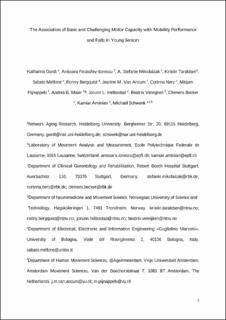| dc.contributor.author | Gordt, Katharina | |
| dc.contributor.author | Paraschiv-Ionescu, Anisoara | |
| dc.contributor.author | Mikolaizak, A. Stefanie | |
| dc.contributor.author | Taraldsen, Kristin | |
| dc.contributor.author | Mellone, Sabato | |
| dc.contributor.author | Bergquist, Ronny | |
| dc.contributor.author | Van Ancum, Jeanine M. | |
| dc.contributor.author | Nerz, Corinna | |
| dc.contributor.author | Pijnappels, Mirjam | |
| dc.contributor.author | Maier, Andrea B. | |
| dc.contributor.author | Helbostad, Jorunn L. | |
| dc.contributor.author | Vereijken, Beatrix | |
| dc.contributor.author | Becker, Clemens | |
| dc.contributor.author | Aminian, Kamiar | |
| dc.contributor.author | Schwenk, Michael | |
| dc.date.accessioned | 2020-09-16T06:54:49Z | |
| dc.date.available | 2020-09-16T06:54:49Z | |
| dc.date.created | 2020-06-21T15:04:20Z | |
| dc.date.issued | 2020 | |
| dc.identifier.issn | 0167-4943 | |
| dc.identifier.uri | https://hdl.handle.net/11250/2677935 | |
| dc.description.abstract | Background
Understanding the association between motor capacity (MC) (what people can do in a standardized environment), mobility performance (MP) (what people actually do in real-life) and falls is important for early detection of and counteracting on functional decline, particularly in the rapidly growing population of young seniors. Therefore, this study aims to 1) explore the association between MC and MP, and between MC and falls, and 2) investigate whether challenging MC measures are better associated with MP and falls than basic MC measures.
Methods
Basic (habitual gait speed, Timed Up-and-Go) and challenging (fast gait speed, Community Balance & Mobility Scale) MC measures were performed in 169 young seniors (61–70 years). MP was assessed using one-week sensor-monitoring including time being sedentary, light active, and at least moderately active. Falls in the previous six months were reported. Associations and discriminative ability were calculated using correlation, regression and receiver operating curve analysis.
Results
Mean age was 66.4 (SD 2.4) years (50.6 % women). Small to moderate associations (r = 0.06−0.31; p < .001–.461) were found between MC, MP and falls. Challenging MC measures showed closer associations with MP and falls (r = 0.10−0.31; p < .001–.461) compared to basic (r = 0.06−0.22; p = .012–.181), remained significant in three out of four regression models explaining 2.5–8.6 % of the variance, and showed highest discriminative ability (area under the curve = 0.59−0.70) in all analyses.
Conclusions
Challenging MC measures are closer associated with mobility performance and falls as compared to basic MC measures in young seniors. This indicates the importance of applying challenging motor capacity assessments in young seniors. On the same note, small to moderate associations imply a need for an assessment of both MC and MP in order to capture the best possible MC and the actual daily-life MP in young seniors. | en_US |
| dc.language.iso | eng | en_US |
| dc.publisher | Elsevier | en_US |
| dc.rights | Attribution-NonCommercial-NoDerivatives 4.0 Internasjonal | * |
| dc.rights.uri | http://creativecommons.org/licenses/by-nc-nd/4.0/deed.no | * |
| dc.title | The association of basic and challenging motor capacity with mobility performance and falls in young seniors | en_US |
| dc.type | Peer reviewed | en_US |
| dc.type | Journal article | en_US |
| dc.description.version | acceptedVersion | en_US |
| dc.source.journal | Archives of gerontology and geriatrics (Print) | en_US |
| dc.identifier.doi | 10.1016/j.archger.2020.104134 | |
| dc.identifier.cristin | 1816488 | |
| dc.description.localcode | "© 2020. This is the authors’ accepted and refereed manuscript to the article. Locked until 6.6.2021 due to copyright restrictions. This manuscript version is made available under the CC-BY-NC-ND 4.0 license http://creativecommons.org/licenses/by-nc-nd/4.0/ " | en_US |
| cristin.ispublished | true | |
| cristin.fulltext | postprint | |
| cristin.qualitycode | 1 | |

